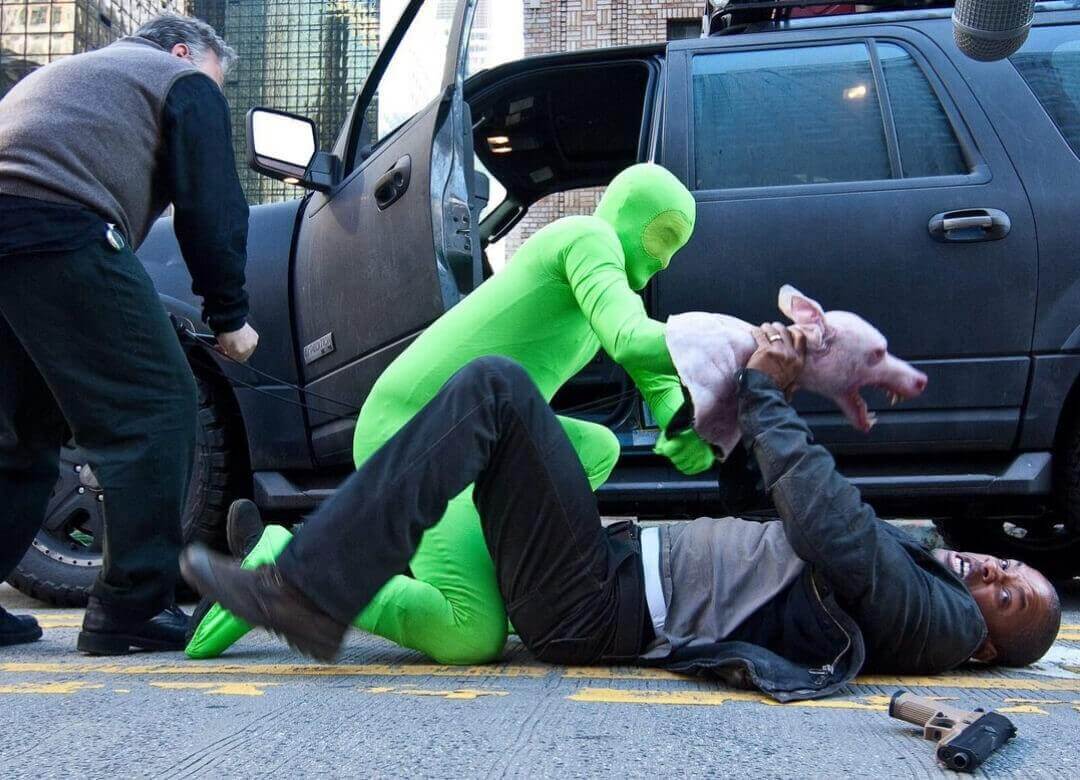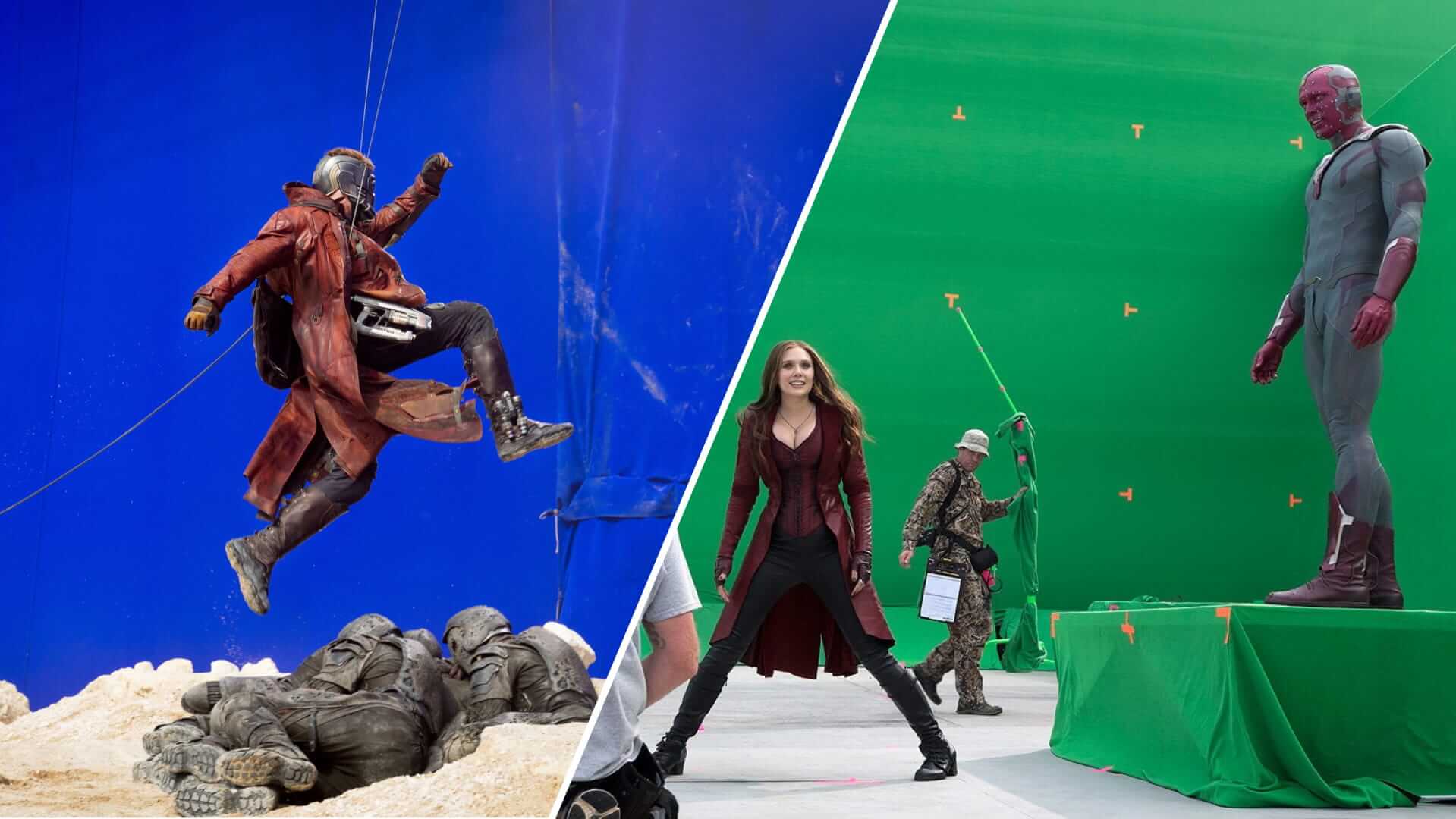If you are at all interested in filmmaking, then you have undoubtedly heard the term ‘green screen’ but have you heard of ‘blue screens’? There are a number of blue screen vs green screen differences and we’ll break all of them down in this post.
Blue screen backgrounds may find slightly less use than green screens but both are widely used in the industry. If you don’t know how blue or green screen technology works, what the difference between blue and green screens is, or why to use blue or green screen backgrounds, then you’ve come to the right place.
Blue green screen technology
Blue screen vs green screen explained
If you know what a green screen background is and how it works, then you actually already know what a blue screen background is. There are differences when it comes to blue screen vs green screen. The two are used in slightly different scenarios and are, of course, two different colors, but are otherwise the same for all intents and purposes.
BLUE SCREEN FILM DEFINITION
What is a blue screen?
A blue screen background is an evenly-lit, monochromatic background that actors perform in front of. The blue (or green) is then replaced with the desired background through chroma-keying. Many films made today heavily utilize blue or green screens.
Blue Screen Film Definition:
- Flat, monochromatic
- Used for chroma keying
- Contextually interchangeable with green screens
There are hundreds of industry specific terms that get thrown around in production offices, on film sets, and in post-production. It’s a good idea to familiarize yourself with as many of these terms as possible if you’re interested in a career in filmmaking. To learn all about these terms, take a look through our Ultimate Glossary of Filmmaking Terms.
Blue screen filming techniques
How blue screen special effects work
A flat, monochromatic background used within a shot allows that portion of the frame to be easily removed and replaced during editing. In this case, the background is colored chroma-key blue.
This chroma-key technique is not confined to backgrounds either; props, production design elements, and even whole costumes can be created as chroma key blue or green and then keyed out in during the Post-Production process. This is perhaps the most common VFX technique used in the modern film industry.

Green morph suit used to pull off convincing dog attack
It is possible to mask out people, objects, or backgrounds and achieve a blue screen effect without using an actual green or blue screen, and this non-chroma-key technique does happen regularly. Monochromatic screens make this process much faster and easier as the removal process must otherwise be done by hand, frame-by-frame.
It isn’t always blue screen vs green screen, sometimes both are used in the same production. In the behind the scenes video below, you will see how blue or green backgrounds were both heavily used during the production of the Bong Joon-ho’s best picture winner Parasite.
Blue screen vs green screen in Parasite VFX breakdown
Chroma-green and chroma-blue are the ideal colors for monochromatic screens in production. The primary reason for this is because chroma-green and chroma-blue are not naturally occurring colors within skin tones and thus make for a clean chroma key featuring performers.
One fun fact about keying is that a chroma-blue, cloudless sky can make for an excellent, large-scale blue screen in a pinch. This blue screen filming technique was used by Robert Rodriguez in one of the best zombie movies, Planet Terror, as a way to execute day-for-night during the film’s climax. Instead of blue screen vs green screen, Rodriguez was able to use the sky itself.
Blue screen movie making in half of the Grindhouse double feature
Related Posts
Blue Screen Filming Techniques
Blue screen instead of green screen
Now we know what the blue screen effect is and how it works, and the differences in blue screen vs green screen. The next piece of information we need to glean is when should a blue screen be used and, more specifically, when should you use blue screen instead of green screen.
As we already covered, green and blue screen colors are interchangeable in many contexts. There are, however, certain factors to take into account when deciding whether to use chroma-key green or chroma-key blue as your monochromatic background.
Color Matching
The most crucial reason to switch from blue screen vs green screen or vice versa would be when a color matching the particular screen is present within the shot. If green is present in the area you plan to mask out, such as a green costume, green foliage, or a simple green prop, then you will be much better off using blue screen special effects when capturing the footage you plan to key out later on in post. The same is true of the inverse if the blue screen color is present within your shot.
To see an example of blue screen movie making in action, check out the video below for a direct instance where proper keying was not possible with a green screen, and thus a chroma-key blue was used instead.
Indy Mogul shows when to use a blue screen instead of a green screen
What should you do if you have a shot that needs to be keyed which contains both green and blue? That’s a tricky situation, and your best option may be to alter the shot itself rather than the matte screen, but there are other options.
As we covered, green and blue are the two best colors for keying but, technically speaking, any solid, monochromatic screen could be used for keying. The trick is to use a solid color that is not present within any person or object in the frame that you do not want keyed out. If what you need keyed out is a lone green and blue prop, then you could use a red screen for instance; matters get far more complicated when introducing a human subject as skin tones contain a wide range of colors.
Luminosity and Light Spill
One additional reason why a blue screen is sometimes preferable to a green screen is due to luminosity. Green has the highest level of luminosity of any color on the spectrum. Because of this, green is the most easily readable and trackable color by digital camera and editing programs. But there is also a potential downside to this high level of luminosity: increased light spill.
Because the color green registers so brightly, it also reflects more light off of its surface which leads to greenish light being cast on performers or objects within the shot, also known as light spill. This light spill can make it more difficult to capture a clean chroma key, especially if the green screen is improperly lit.
Blue or Green Screen Background Lighting
Blue screen compositing, on the other hand, does not have this light spill concern to the same degree and they are also slightly easier to light cleanly but they do register darker through digital cameras.
When it comes to blue screen vs green screen, one is not definitively better than the other; there are instances where each is preferable. A good filmmaker knows how to adapt to different situations and solve problems through a variety of means.
UP NEXT
Ultimate Glossary of Film Terms
Now that you have a firm understanding of both green and blue screens, it’s time to continue researching other unfamiliar filmmaking terms. Do you have a grasp of Plato’s allegory? Do you know what a U-matic is? How about a Klieg light? All of these terms and more are explained in our Ultimate Glossary of Filmmaking Terms.
Up Next: Glossary of Film Terms →
Showcase your vision with elegant shot lists and storyboards.
Create robust and customizable shot lists. Upload images to make storyboards and slideshows.
